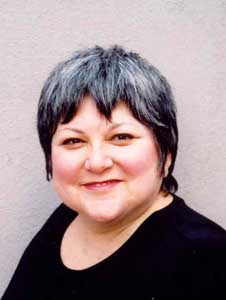-
- Calif. high court appears inclined to rule against same-sex marriages
- MTV Networks announce Logo, network geared toward gays and lesbians
- Aetna sues Abbott over 400 percent rise in AIDS drug price
- GLAAD starts contest to get America to say ‘I Do’ to same-sex marriage
- Missed goals, dwindling participation leads Pittsburgh to cancel AIDS walk
- New Mexico company gives gifts to gay and lesbian couples married in Mass.
- National News Briefs
- World News Briefs
feature
Doug Wright: on the edge of sexuality and theater
Published Thursday, 03-Jun-2004 in issue 858
Doug Wright’s Pulitzer Prize-winning drama I Am My Own Wife may not have even received mention in the San Diego Union-Tribune’s “Plays to Ponder” feature last month, but it did get the attention of the Republican National Convention. In good company with the musical Avenue Q, Wright’s I Am My Own Wife, which was workshopped and presented at the La Jolla Playhouse last year and which has received three Tony nominations, landed itself on the RNC’s list of plays in New York that are “incompatible with the family values of the Republican Party”, a list distributed to delegates at this year’s RNC being held in New York.
And Doug Wright says that’s even better than being nominated for a Tony.
Wright’s play, which is nominated for Best Play, Best Performance and Best Direction of a Play, has taken New York by storm, and is Vegas’ odds-on favorite for Best Play at this Sunday’s Tony Awards ceremonies, broadcast June 6. But the ever-gracious Wright won’t even take the bait. He is, actually, a master in deflection.
“I don’t know, I don’t know,” says Wright when asked what he thinks his odds are of winning. “If you get too definitive or cocky, it can be dangerous. Besides, speculating on whether I will win takes away from the truly important issues like, ‘What will I wear?’”
Tonys aside, Wright has taken this labor of love very seriously. Best known for his subversive script of Quills (later a Golden Globe-nominated film starring Geoffrey Rush as the Marquis de Sade), Wright spent 10 years writing I Am My Own Wife. And according to Wright, time simply wasn’t an issue.
“I found [the character of] Charlotte [von Mahlsdorf] endlessly compelling and fascinating,” says Wright. “Her stories were rip-roaringly good and had all the attend and excitement of an espionage thriller. But she also spoke in very basic ways about the human experience and what it means to hang onto your own iconoclasm in a largely conformist culture. I think that is what compelled me to write about her.”
So who was this muse, Charlotte von Mahlsdorf? Wright was actually introduced to von Mahlsdorf by his friend, John Marks, who was stationed in Germany in 1990 as the U.S. News and World Report bureau chief. Born Lothar Berfelde in 1928, von Mahlsdorf decided early on that women’s clothing suited her better and, with the help of a lesbian aunt, lived openly as a transvestite, surviving both the Nazi and the Communist regimes in East Berlin. She claimed herself an avid supporter of lesbian and gay causes, and even claimed to have installed a banned gay restaurant and bar in her cellar.
And like all good theater, von Mahlsdorf’s life was full of contradiction. While maintaining a self-described staunch defiance of authority under the Nazi and Stasi regimes, she also functioned as an informant for the East German government. Ironically, she was the one who gave the SS file to Wright. She had a love for and a loathing of her German heritage. She was, at the same time, the protagonist and antagonist.
“Charlotte was very blasé about the fact that she was a transvestite,” says Wright, “but she was deeply excited by her extravagant furniture collection.”
From this, Wright says, he took his cue.
“The best way to portray her was simple and matter of fact,” says Wright, “because that is how she presented herself.”
Even the costuming is matter-of-fact. Actor Jefferson Mays remains throughout the piece in a black dress with pearls, a black scarf on his head, black stockings and heavy black shoes. But there is nothing simple about Mays’ acting in the play. Mays must affect around 40 different personas, physical demeanors and accents, ranging from Teutonic to American to British.
Mays’ performance as von Mahlsdorf has earned him critical acclaim and a Tony nomination for Best Featured Actor in a Play. In one interview, Mays said, “It is somewhat strange to be making your New York theater debut alone.”
But Mays was not alone. Wright and Mays worked very closely in collaboration, along with Moises Kaufman, best known to San Diego audiences for Gross Indecency: The Three Trials of Oscar Wilde and The Laramie Project, now the most widely performed drama in high schools and colleges across America.
The powerhouse collaboration between the three began at the Sundance Theatre Laboratory and continued at the La Jolla Playhouse here in San Diego.
Shirley Fishman was the dramaturge assigned to the piece at Sundance and continued with it at the La Jolla Playhouse.
“I remember one of the first days of rehearsal,” recalls Fishman, now an associate artistic director and dramaturge at the Playhouse. “Moises asked Jefferson to go outside, walk past the windows, come to the double doors and make an entrance. That has remained from the very first day, in that room.”
“Another time,” says Fishman, “Jefferson came in and he had made these little miniatures of the [1890s] furniture [that von Mahlsdorf collected]. He put them in a box, and they have been part of the production ever since.”
Wright was especially pleased with the dramaturgical collaboration as he shaped the play.
“Jefferson was very active in the piece,” says Wright. “Even before I wrote the first word I said, ‘I want to write this for you, but please, let’s do it in workshop. I need your help, your eye, your vision.’ And he granted me all those things. It was the most collaborative piece I have ever done.”
So why choose San Diego and the Playhouse for the workshop?
Wright explains: “I think it is a safe environment, away from the prying eyes of the New York critics, and really gave me the opportunity to explore the play in an unguarded way. It also allowed us the collaboration element. For better or worse, New York is the theater capital of the United States, and once a work premieres [in New York], the future of the work is forever determined. You are only given one shot. I think that is why, increasingly, artists are choosing to do work in culturally rich communities with engaging audiences who will challenge the artist to do the best work possible but won’t slander you in the press afterwards.”
Wright is, in fact, very cognizant of the audience’s reaction to his art.
“After doing Quills,” says Wright, “I have become very accustomed to audiences leaving the theatre throwing me these wary glances like, ‘Ohhh, you creeped me out.’ With I Am My Own Wife, they leave with beautiful smiles, eyes rimmed in red from a little crying. And they rush up and kiss me and give me hugs. It’s two very different experiences.”
And Wright suggests this is clearly a result of where the two pieces originated.
“Quills was fueled by my own post-adolescent rage at the world,” says Wright. “I am deeply proud of the play, but I am quick to admit that I wrote it out of a truly corrosive anger and sense of political outrage at the cultural wars that were going on in the country, most notably those surrounding the National Endowment for the Arts. It was a play forged in a cauldron of anger.”
If the first was wrought from rage, says Wright, the second was born of love.
“I Am My Own Wife was actually written out of a very deep and abiding love for my subject, Charlotte,” says Wright.
And his next endeavor?
“I will be working on a film script for the actress Reese Witherspoon,” says Wright. “It is a remake of a movie from 1965 called Bunny Lake is Missing, directed by Otto Preminger. It’s a harrowing little tale about a lost child and I hope it has people biting their nails down to the quick.”
So far, both of Wright’s best known works have seemed to fancy sexuality — and politics. Writing about sexuality is nothing new. And certainly, there is nothing new about men dressing as women in theater. While Mays manages to bring von Mahlsdorf’s life to a more ecumenical experience, allowing a sense of femininity to come through, there is still an element that keeps the audiences viewing von Mahlsdorf’s life as theater. And Wright is very aware of this.
“I think that as a culture we have only progressed so far,” argues Wright. “We have come to accept drag queens because they entertain us, they mock the culture, they function as satirists, they allow us to laugh, they titillate us. But transgender people in the world are still deeply threatening because they remind us that gender, the whole notion of gender, is a kind of artificial construct and that male and female exist on a slippery biological continuum and that they are not the binary absolutes that we would like them to be.”
In other words, the audience is generally accepting of an issue as long as it remains “entertainment” and not “politics.” But can the two really be separated?
For Wright, it is the story that matters. And making the story speak to the audiences. But sometimes, stepping back from the result can turn something daunting into something haunting.
“I spent the last 10 years writing about an individual who survived in a world where discrimination against gays and lesbians was sanctioned by law,” says Wright. “[President George] Bush wants to do the same thing with the constitutional amendment prohibiting gay marriage. It is very chilling that suddenly Charlotte’s culture isn’t the exotic ‘other’ any more. That it suddenly mirrors our own in some way is very chilling.”
|
|
Copyright © 2003-2025 Uptown Publications



